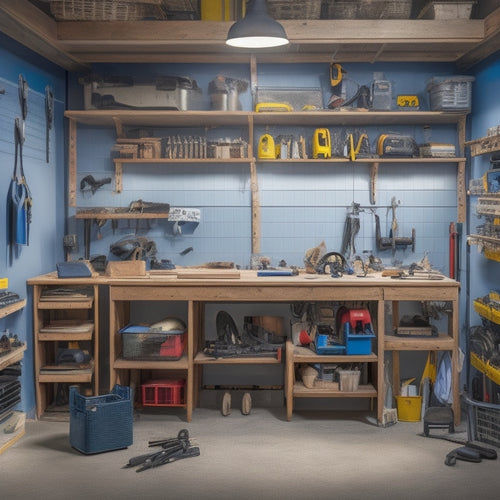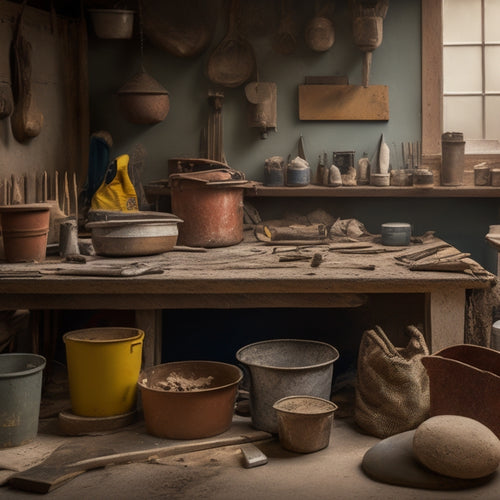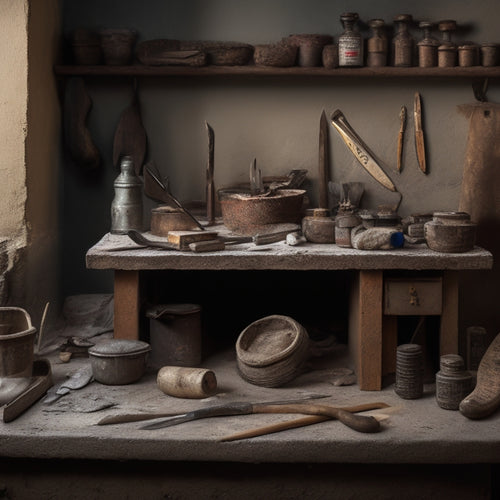
Top 5 Tools for a Flawless Flooring Renovation
Share
You'll need a visual inspection tool to assess sealed cement floors for damage and wear, a reliable flooring gauge to measure floor thickness accurately, a moisture meter to detect subfloor moisture issues, and an acoustic testing tool to identify hidden defects easily. Additionally, an all-encompassing evaluation tool will help you assess floor surface conditions and identify potential renovation obstacles. By incorporating these top 5 tools into your flooring renovation, you'll be well-equipped to tackle any challenge that comes your way - and uncovering the secrets to a truly flawless finish is just a step away.
Key Takeaways
• Utilize a reliable flooring gauge for precise measurements to ensure accurate material calculations and avoid costly errors.
• Invest in a moisture meter (pin-type, pinless, or capacitive) to detect hidden defects and subfloor moisture issues.
• Employ a comprehensive visual inspection to identify cracks, unevenness, stains, and discoloration affecting adhesion and installation.
• Acoustic testing is essential to detect unusual sounds indicating hidden defects, such as water damage or structural issues.
• A thorough subfloor inspection kit can help uncover renovation obstacles, including efflorescence, stains, and unevenness.
Inspecting Sealed Cement Floors
When evaluating sealed cement floors, you'll want to begin by visually inspecting the surface for any signs of damage, wear, or irregularities that could affect the renovation process.
Check for cracks, chips, or unevenness, as these can impact the adhesion of new coatings or finishes. Also, inspect the floor sealant type and its condition, as this will influence your renovation strategy. Different floor sealant types, such as epoxy, polyurethane, or acrylic, require specific maintenance techniques and may have varying levels of durability.
Next, assess the floor's cleanliness and porosity, as these factors will affect the bonding of new materials. Look for signs of efflorescence, staining, or discoloration, which may indicate underlying issues that need to be addressed.
Take note of any existing coatings or finishes and determine if they need to be removed or can be built upon. By conducting a thorough visual inspection, you'll gain an extensive understanding of your floor's condition and be better equipped to select the right tools and techniques for a successful renovation.
Measuring Floor Thickness Accurately
With a clear understanding of your floor's surface condition, you can now focus on measuring its thickness accurately, a critical step in determining the best renovation approach and selecting the right materials. To achieve precise measurements, it's crucial to employ the right tools and techniques.
When it comes to measuring floor thickness, you'll need a reliable flooring gauge. This handy tool allows you to accurately assess the depth of your flooring, guaranteeing you choose the correct materials and avoid costly mistakes.
Here are three key considerations for measuring floor thickness accurately:
-
Select the right flooring gauge: Choose a gauge specifically designed for your flooring type, whether it's hardwood, concrete, or tile.
-
Master various measurement techniques: Familiarize yourself with different measurement methods, such as the 'core drill' or 'pull-up' techniques, to guarantee accurate readings.
-
Account for variations in floor thickness: Take multiple measurements across the floor to account for any inconsistencies in thickness, guaranteeing a precise calculation.
Detecting Subfloor Moisture Issues
You'll need to identify any subfloor moisture issues before proceeding with your flooring renovation, as undetected problems can lead to costly repairs, safety hazards, and compromised flooring performance.
A thorough subfloor inspection is essential in detecting moisture issues that can affect the integrity of your flooring. You can use moisture meters to measure the moisture levels in the subfloor.
These meters come in different types, including pin-type, pinless, and capacitive meters. Pin-type meters are ideal for measuring moisture in wood subfloors, while pinless meters are better suited for concrete subfloors. Capacitive meters, on the other hand, can measure moisture in both wood and concrete subfloors.
When using a moisture meter, make sure you follow the manufacturer's instructions and take multiple readings from different areas of the subfloor. This will give you an accurate picture of the moisture levels and help you identify any areas that require attention.
Evaluating Floor Surface Conditions
Accurate assessments of floor surface conditions are essential to determining the ideal renovation strategy, as imperfections can greatly impact the final result.
As you prepare for your flooring renovation, it's vital to evaluate the surface conditions of your floor to identify any issues that need to be addressed. This process is critical to achieving a flawless finish.
When evaluating your floor's surface conditions, consider the following key factors:
-
Cracks and fissures: Look for any cracks or fissures in the surface, as these can affect the adhesive properties of your new flooring.
-
Surface unevenness: Check for any unevenness or dips in the floor, which can impact the installation of your new flooring.
-
Existing finish: Assess the condition of the existing finish, including any wax or sealant buildup, to determine the best approach for flooring preparation.
Identifying Hidden Defects Easily
Beyond the obvious cracks and surface imperfections, your floor may harbor hidden defects that can derail your renovation plans, and it's crucial to uncover them early on. You can't afford to overlook hidden damage, as it can lead to costly repairs down the line. To identify hidden defects easily, you'll need to employ the right inspection techniques.
Here are some crucial inspection methods to incorporate into your flooring renovation:
| Inspection Technique | What to Look For | Why It Matters |
|---|---|---|
| Moisture Testing | Excessive moisture levels | Water damage can lead to warping, buckling, or rotting |
| Acoustic Testing | Unusual sounds or vibrations | Hollow spots or unevenness can indicate hidden defects |
| Visual Inspection | Discoloration, stains, or unevenness | Can indicate hidden water damage, rot, or structural issues |
Frequently Asked Questions
Can I Reuse Old Flooring Materials in My Renovation Project?
When deciding whether to reuse old flooring materials, you'll need to assess their condition and potential for upcycling.
Inspect the materials for damage, wear, and tear. If they're still in good shape, you can consider refinishing or repurposing them using various upcycling techniques.
However, if they're beyond repair, it's better to opt for new flooring materials to guarantee a durable and long-lasting result.
What Is the Recommended Safety Gear for Flooring Renovation Work?
When tackling a flooring renovation, you'll want to prioritize your safety above all else.
You're working with power tools, heavy materials, and potentially hazardous substances, so it's essential to gear up properly.
You should always wear safety goggles to protect your eyes from debris and dust.
Additionally, don't forget to don a dust mask to prevent inhaling harmful particles.
How Do I Choose the Right Flooring Contractor for My Project?
As you're preparing for your flooring renovation, it's no coincidence that finding the right contractor is a vital step.
You're taking the right approach by doing your due diligence. When choosing a contractor, prioritize their qualifications, ensuring they've the necessary licenses, certifications, and experience.
Research flooring reviews to gauge their reputation and quality of work. By doing so, you'll increase the chances of a successful project that meets your expectations.
What Is the Average Cost of a Flooring Renovation Project?
When planning your flooring renovation project, you'll need to take into account the average cost to set a realistic renovation budget.
Flooring material costs vary widely, ranging from $3 to $15 per square foot, depending on the type and quality.
As you plan, factor in additional expenses like labor, underlayment, and installation.
You'll want to allocate 10-15% of your overall budget for unexpected expenses.
Can I Do a Flooring Renovation Project on a Tight Deadline?
You've got a tight deadline for your flooring renovation project, just like the Smiths, who transformed their entire home in just three weeks.
To pull off a feat like this, you'll need to master time management and project planning. Create a detailed schedule, identifying critical tasks and allocating realistic timeframes.
Prioritize tasks, delegate when possible, and maintain open communication with your team to guarantee a flawless execution.
With meticulous planning, you'll be enjoying your new floors in no time.
Conclusion
You've navigated the flooring renovation minefield, and now it's time to put the puzzle pieces together.
With these top 5 tools, you've got the blueprint for a flawless floor makeover.
Think of it as charting a course through treacherous waters - with the right navigation, you'll avoid hidden shoals and emerge with a stunning, seaworthy floor that will withstand the tides of time.
Related Posts
-

Why Home Renovators Need Smart Tool Storage Now
You need a smart tool storage system that streamlines your workflow, reduces clutter, and protects your investments b...
-

What Plastering Tools Do You Need for Renovation
You'll need a range of specialized tools to tackle a plastering renovation project efficiently and effectively. Essen...
-

Stucco Tool Kit Checklist for Home Renovation
You'll need a thorough stucco tool kit to guarantee a successful home renovation, as the right tools can make all the...


